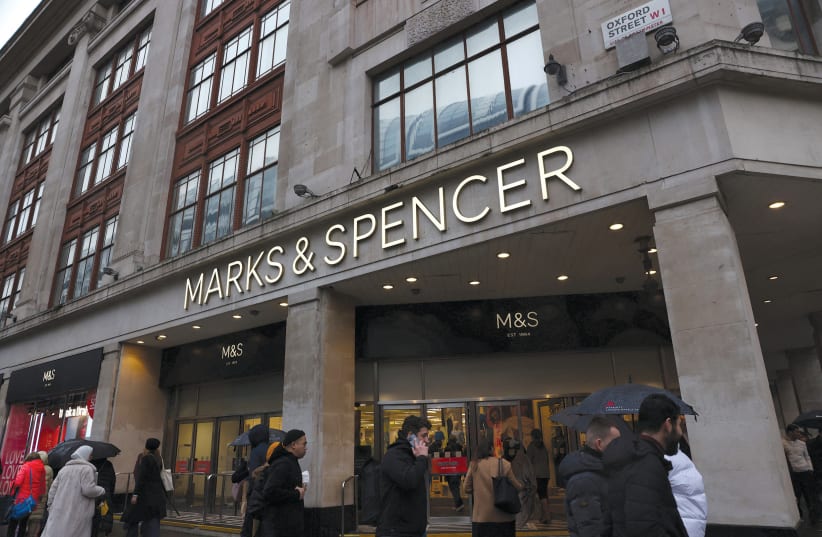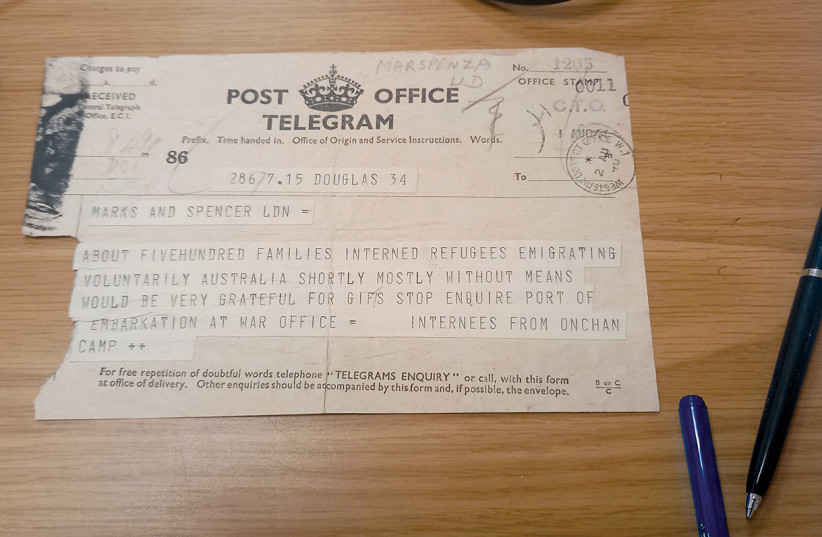After 42 years as a lawyer in practice in Jerusalem, I decided I wanted to try retirement. As it happened, “retirement” lasted only six years, and I went back to my practice. In those retirement years, while looking for voluntary work that would suit me, I ventured into the Central Zionist Archives in Jerusalem, which was looking for people of my ilk.
Being an English speaker by education, I was offered a “collection” of over 25,000 documents, mostly in English, which had been amassed by one J. Louis Cohen, whom I had never heard of. I accepted the task, and over the following year I did indeed peruse and catalogue all those many documents.
I mostly did so with my mouth agape because unfolding before my eyes was an incredible story of courage and determination of the partners and staff of Marks & Spencer, who had played a central and organizing role in the rescue and rehabilitation of the desperate, persecuted Jews of Europe in the years leading up to World War II.
How did Marks & Spencer save European Jews before the Holocaust?
Simon Marks, Israel Sieff, Harry Sacher, and their personal assistant Louis Cohen used their enormous influence in England to raise and channel monies, recruit the top echelons of British society to the cause, bring on board the Jewish communities of the United States, and “move mountains” to further the aims which they had set themselves.
Marks placed upon Cohen, who was his chief accountant and economist, the task of recording and collecting every piece of paper, every report, every newspaper article, and a record of the activities of M&S during the period from 1932-1941, when Cohen passed away. It was not long after they started becoming involved, that almost all matters and proposals relating to the problem of the Jewish refugees came to be dealt with through M&S.
They worked to get the Jews out of Germany and Poland. They set up a legal (or semi-legal) structure to get the money and property of those hapless people out of the countries where the persecution was intense and increasing day by day. They vetted and proposed plans to resettle the Jews in such exotic countries as Brazil, Ecuador, Madagascar, Kenya, British Guiana and, of course the US and Canada, as well as, in some cases, providing a transitory refuge in the Azores islands of Portugal until the visas were obtained.
In 1936 Simon Marks, Lord Biersted, and Viscount Sir Herbert Samuel, accompanied by Cohen, sailed on the transatlantic liner Majestic to the US. As reported in February 1936 in The Jewish Chronicle, “Over a period of 15 days, they addressed all shades of American Jewish opinion, which always ended with promise of full support. They visited, jointly or severally, New York, Chicago, Baltimore, Philadelphia, St. Louis, and Washington; made over thirty speeches and five broadcasts,” thereby bringing into the rescue operation the Jews of the US who hitherto had been mostly unaware of the plight of their brethren in Germany and Poland. A significant result of that trip was the decision, advocated by Sieff and Sacher, to appropriate one half of all monies collected for the resettlement of Jewish refugees in the nascent Jewish state in Palestine.
One of the substantial tasks that fell upon the directors of M&S was the question of the Jewish refugees who had gone to England, only to find that they were classed as “enemy aliens,” and several thousand of them were interned in some dozen internment camps all over the British Isles. Husbands were separated from wives and children and, in some cases, were shipped off to Australia, and their families were not notified of their whereabouts. Many of these people were highly educated – professors, scientists, mathematicians, lawyers, musicians; indeed, every possible profession. Marks and Cohen prepared pages and pages of lists of the internees, with a short resume of their qualifications and experience, and proceeded to try to get them released into the British scientific and industrial structure and workforce. They documented several scientists whose innovative discoveries and research proved to be invaluable and who were ultimately incorporated into the war effort and the British air defense system.
I recall being completely taken aback as I read through some of the CVs and found, under the heading “Musicians,” the name of Isi Geiger, described then as the band leader of the top Jewish band in Vienna. The same Isi Geiger was the band leader at my wedding in London in 1965.
Pleas for assistance came into M&S from almost everywhere where European Jews were being persecuted; and offers of help landed on the desk of Simon Marks from such varied sources as the owners of the Dunraven Castle in Glamorganshire, the Australian Jewish Committee; and even such groups as The Boys Scouts Association of England. They organized the establishment of hachshara [preparation] farms in Holland and in England.
On May 2, 1936, a letter arrived from The Institute for Advanced Study, School of Mathematics at Princeton University in the US from none other than professor Albert Einstein in which he appealed to “Hochgeerter Herr Marks” to save his friend professor Jacob Klatzkin. One of the greatest Hebrew scholars of the time, who wrote and published the standard Dictionary of Hebrew Philosophy and many books of Judaism, philosophy, and Zionism, Klatzkin had been dismissed from his work and had been languishing in Switzerland with no money and no prospect of employment.
In that same month, Cohen received a letter proposing the resettlement of the German Jewish refugees in “The Aproaga Freehold Estate – 770,000 acres situated on the Capim River 70 miles from the capital Belem-Para on the mouth of the Amazon River in north Brazil – most fertile soil yielding two crops per year.” These and other appeals, ideas, plans, and projects typified the work and devotion of M&S to the cause of helping their co-religionists to escape the desperate misery and hopelessness of the Jews of Europe during the period leading up to WW II and the Holocaust.
It is a story which is mostly unknown and, in my humble opinion, is begging for a research assistant to properly investigate and perhaps base a doctoral thesis on the subject. It is a story that must be told.■

